Hearty, easy to make Bratkartoffeln German Fried Potato is another German dish that Japanese love and make often at home. You can cook Bratkartoffeln in under 20 minutes. German pan-fried potatoes are great for a busy weekday dinner!
Why Bratkartoffeln is on a Japanese food blog?
I am sure that you are wondering why this German dish is on a Japanese food blog. Some German foods such as Baumkuchen are more popular and well known in Japan than they are in Germany. I have been sharing German food that the Japanese absolutely love and make often at home. My Mother often cooked Bratkartoffeln because she loves potato and bacon. And who doesn’t?
German sausages in Japan
You need sausages to make Bratkartoffeln German pan-fried potato. My mother always made this with a sausage called “Schäussen (shauessen in Japanese)” or “Alto Barbaria (aruto baierun in Japanese)” which are popular sausages in Japan. The size of the sausages in Japan is significantly smaller compared to the size of the German sausages such as the Bratwurst found in Australia.
What types of potato is good for making Bratkartoffeln?
Making Bratkartoffeln easier to cook, I first cook the potato and then fry it with sausages and bacon. I want to keep the shape of the potato whilst also aiming for the “hoku hoku” texture. It is a hard onomatopoeia to translate, but it is the comforting softness and warmth of the starchy steamy potato texture. So to achieve keeping both shape and the texture, I use an all-rounder potato. If you would like to read more about potato types, check out my post “Japanese potato Croquettes”
The best dish with German Beer
Often dishes pair with wine or sake, however, I believe that German beer is the best match with Bratkartoffeln. A few years ago, I travelled the Romantic Road with my friend. We tried a German house beer in Rothenburg ob der Tauber recommended by a German gentleman who shared a table with us. It was the best ever beer I have tasted and would best suit this Bratkartoffeln to drink and eat with. However, we don’t have the beer here, so I would recommend Japanese beer.
My fond memory of Germany and recommendations
It was cold though I definitely recommend visiting at Christmas time and go to as many Christkindlmarkts as possible. Every Christkindlmarkt is different with beautifully lit up Christmas trees, lots of delicious German food stalls, and heartwarming atmosphere. You will find German people drinking gluhwein chatting and laughing and children on a beautifully lit merry-go-round. And definitely try German house beer! It is absolutely delicious even when drinking beer in winter.
And if you ever have a chance, visit Füssen. We drove to Füssen from Rothenburg ob der Tauber making my record fastest 174km/hour!! It was an amazing experience to drive a car that fast (well, I did not, my friend did). When we arrived in Füssen, it was a cold and kind of dull and cloudy day but next morning, I was woken up by my friend saying “It makes Shiho very happy!” It snowed overnight and still was snowing. It was just so beautiful and magical, I will never forget.
Genießen Bratkartoffeln! I hope you enjoy German fried potato!
If you liked the recipe, please rate it and leave a comment below. Check out my other German recipes that Japanese love such as Baumkuchen and Easy soft pretzel.
Also, don’t forget to follow me on Youtube, Pinterest, Facebook , Twitter and Instagram . This way you keep up to date with all the latest happenings on Chopstick Chronicles. Don’t forget to Sign up for a weekly newsletter so never miss out authentic delicious Japanese recipes! Sign up form is on the right-hand sidebar.
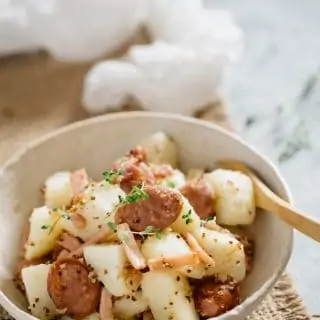
German Potato
Equipment
Ingredients
- 50 g Japanese or German sausages
- 300 g potato
- 2 slices of rindless bacon
- 1 clove of garlic
- 1 tsp whole grain mustard
- 1 tsp olive oil
- salt and pepper to taste
- Chopped Parsley or fresh thyme to garnish
Instructions
- Wash the potato well and cut them into small bite size pieces.
- Slice the sausages about 1cm thick and cut the bacon into small pieces too.
- Place the potato in water (just cover the potato) and bring to boil over medium heat. Cook the potato for about 10 minutes or until the potato becomes soft. Drain the water.
- Heat olive oil in a large frying pan over high heat and crush the garlic into the frying pan.
- When the garlic becomes fragrant, add the bacon and sausages into the frying pan. Cook the bacon and sausages till brown.
- Add the cooked potato and mustard to the frying pan. Stir and fry them all together and add salt and pepper to taste.
- Serve and garnish with Parsley or Thyme *1
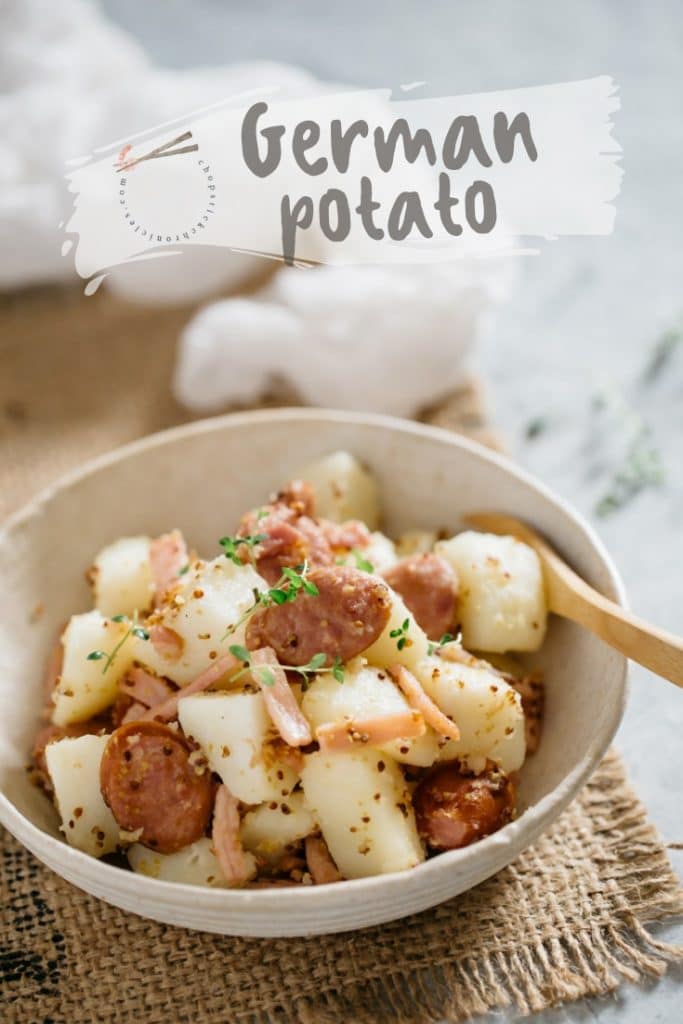
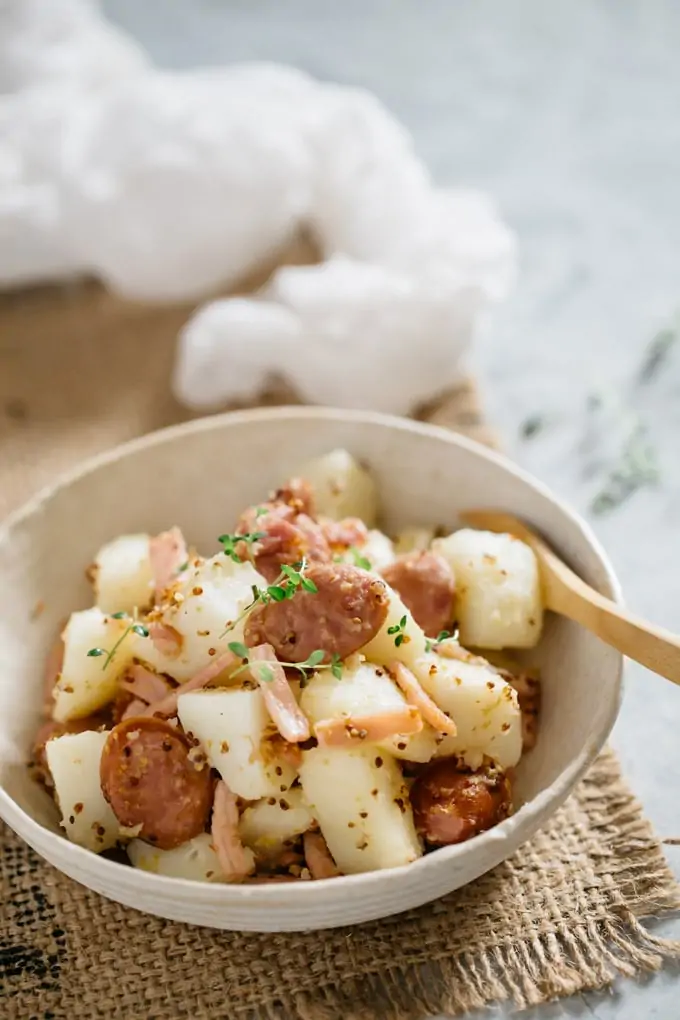


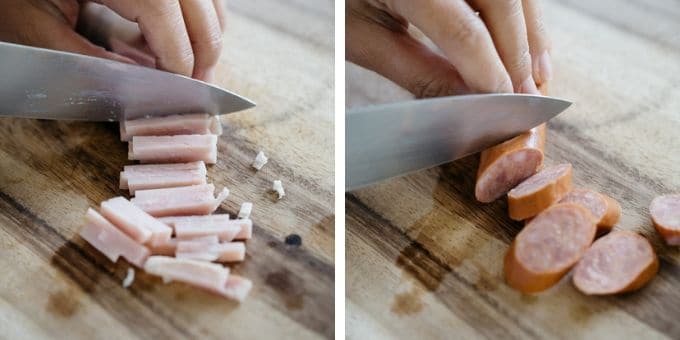

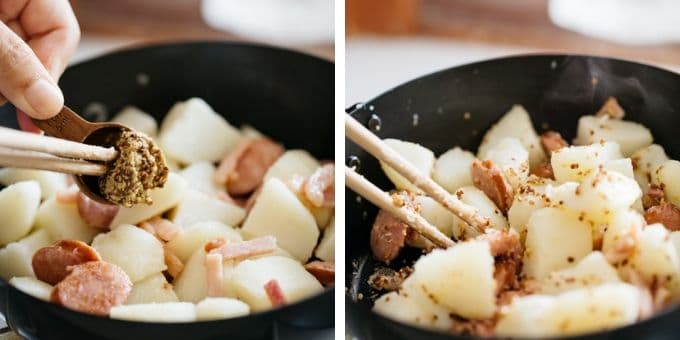



Sounds and looks wonderful. I can’t wait to try.
Thank you for your suggestions. I like using boiled cold potatos left in fridge overnight and the bacon fat to fry these up and of course oniins.
Thank you for sharing your ideas about bacon fat and potatoes Sonya 😀
Hi Shihoko, I’ve been reading and cooking your recipes for a while and I really like how you steer between the traditional and adaptations to suit what you can get regarding ingredients or personal taste preference.
Your Bratkartoffel version is really a shining example of adaptation.
So, maybe you will enjoy reading or even trying my family’s version of Bratkartoffeln.
It should be made with “festkochende” potatoes. I found the translation lacking very much (waxy). It’s the type of potatoe that keeps it’s shape when cooking and doesn’t crumble when you press on the cooked one. It’s the opposite of ‘mehligkochend’, which is the starchy type that you want when smashing them up after cooking (e.g. for the croketts that you make).
Potatoes should be cooked with peel ON. And at least be ‘left over’ in the fridge for 1 day. It’s just with rice for fried rice. The recipe was invented to use the left overs. The resting time helps the potatoes to dry, which increases their fry-ablility. The best Bratkartoffeln are made from those pre-cooked potatoes that you almost forgot were still down there in the vegetable drawer of your fridge.
Just before frying, peel and cut the potatoes into thin slices. Don’t worry if they break up. That gives you the tiny bits that get really brown and crunchy.
For frying, ideally use a heavy iron pan that spreads the heat evenly. I use lard (Schweineschmalz) for frying. Some people don’t like the taste, so any neutral frying oil will do. Indian Ghee or “Butterschmalz”(sorry, dunno translation…basically, melt butter, filter the protein parts, use only the fat) will also give a nice taste and crust. Butter alone will burn to early.
Use generous amounts of frying fat. And then add a bit more. Fry long time over low heat rather than short and hot. Don’t stirr to much while frying. Let it sit for a while. If you know how to toss stuff over by just moving the pan, that’s your go to technique here.
When the small, broken off parts are getting black, all the potatoe pieces have a nice golden brown crust at least, that’s when you can salt and pepper, drain a bit of that fat, serve sizzling hot.
We eat Bartkartoffeln to a wide variety of dishes from pan fried saussages, those typical German meat balls that have a myriad of different names (Fleischkuechle, Frikadellen, Fleischpflanzerl…depending on local dialect) or Matjes (a type of perserved fish).
In my home town and around, we have an akronym for our favorite way to eat Bratkartoffeln: WuBiBrä. It’s WUrstsalat BIbbeleskäs BRÄgele. Brägele is the dialect word for Bratkartoffeln in my home region.
Yes, you guessed correctly: Wurstsalat is in fact a salad made from sausage. Local producers even offer it pre-cut for the salad https://www.schwarzwaldhof.de/produkt/lyoner-in-streifen/ because it’s so popular.
Bibbeleskäs is our dialect word for something like a cottage cheese type of dairy product. You can guess the BUT coming, as those dairy products are so different everywhere and German ‘Quark’ is different from French ‘Fromage Frais’. The real version is hard to get these days because it’s made from raw milk “going sour”, seperating the whey from the cream. Because raw milk is hard to get these days, and restaurants are not even allowed to handle it because (yes, it can… sometimes) be a source of infection, Bibbeleskäs these days is usually kind of ‘Quark’ with some ‘Frischkäse’ mix. As you’re good with fermentation (miso!), you might give it a try if you can get hold of non-homogenized fresh milk. Adding a bit of yoghurt can help the milk getting sour.
The crunch of the potatoes, the sourness and raw onions in the Wurstsalat and the fatty, creamy yet tangy freshness of the Bibbeleskäs make a trio from culinary heaven.
I stumbled on your Bratkartoffel recipe while checking out your japanese recipes and I have some remarks to make:
I’ll advise against freshly cooked potatos to make Bratkartoffeln. You either use uncooked ones, as Sina suggested, or you take the leftovers from a previous day. When using leftovers the effect is nearly the same as using the rice from the previous day to make fried rice. If you go the uncooked route, I recommend to put the cut potatos in a bowl of cold water to get some of the starch out and maybe go for slices instead of cubes.
In addition I would advise against using olive oil to fry them, simply because you can or should not heat it up as much. Either use the fat of the bacon or pork belly, that you fried before, or use lard. When tend to use both. You get a better taste when using animal fat and due to the higher temperature you get the potatos also nice and crispy.
We usually pair Bratkartoffeln here in Germany with onions. So feel free to fry one with the potatos together.
Hi Chris, Thank you for your advice 😀
I have made this dish at least 5 times now and it is perfect every time. SO YUMMY! My 3 children plus the husband all rave over it.
Ohhh That’s fantastic! I loved when my mom used to make for dinner 😀 I glad your family enjoying this German-Japanese dish!
Love reading about the fond memories! I love the combination of both Japanese and German cuisine, This sound so incredible and extremely flavorful!
Thank you Tisha 😀
Ah, you have such fond memories of your trips to Germany. I have not been, but I’d like to. Also, this salad is very similar to something my Mother used to make for us on holidays in Europe. So simple yet delicious – thanks for sharing it.
You are welcome and Thank you for 5 star rating Jane 😀
wow i really enjoyed this recipe!
Oh great 😀 thank you!
Hello from Hamburg, Germany!
I love Japanese recipes and the Japanese culture, so it is funny to discover a recipe like this here 🙂
My mom makes the best Bratkartoffeln ever, maybe you want to try it someday if you fancy Bratkartoffeln again:
peel potatoes, and slice or cut them finely. Put them onto a fresh towel and wrap it around, to get some of the starch out. Heat butter in a large pan, the bottom has to be covered with butter generously. Put the raw (!) potato slices in and fry, turning from time to time to get them brown and crispy from all sides, add butter if needed. Add salt and pepper as you like it.
Enjoy!
Hello Sina 😀 Thank you for the authentic recipe! I will definitely try that 😀 don’t you add any sausages or bacon? I travelled Germany in December from Dusseldorf to Munich and loved it!! I desperately wanted to eat authentic “Baumchen” which Japanese people loooove and eat it a lot in Japan, probably we eat it more than German people do 😀 You can find and buy Baumchen anywhere in Japan in fancy department stores and even in supermarkets and convenience stores. I did not find any baumchen while I travelled in Germany. Funny isn’t it? oh, Don’t forget to check out my baumchen and soft pretzel recipe too 😀
Dear Shihoko, I don’t add meat as I am vegetarian and my mum didn’t add it, too, but I know a lot of people eating it with bacon! I prefer fried eggs with it, with soft and runny egg yolks – so good!
Ah you mean Baumkuchen! It is more popular around christmas time than in the rest of the year, and sometimes you can find it on christmas markets, but Lebkuchen (gingerbread) is much more common. I’d say it is considered as something more oldfashioned in Germany, but I love it, especially covered in milk chocolate! If you’ll try next time having some authentic Baumkuchen while in Germany, I would recommend searching for an oldfashioned “Konditorei” which are bakeries that sell mainly cake and sweet pastry, you won’t find Baumkuchen in usual bakeries.
Feel free to contact me when you need any tips or recommendations about German food or anything!
Your blog is awesome!
Ohhh Thank you Sina, soft runny egg yolks sounds so delicious! Thank you, I have tried to make Stollen too as it is very popular German bread at Christmas time in Japan although many Japanese are not Christian. I have one recipe ready to post in next Christmas time 😀 and Thank you for the information. I would love to visit Germany again and will try Konditorei next time 😀
We too love Germany! We lived there for 6 years in pre-reunification days. We also contrive to drive through Germany and eat ourselves to a standstill when we are driving to Italy. A couple of years ago we also toured the old East Germany and stayed in Dresden. Rothenburg ob der Tauber is one of the prettiest towns anywhere, and we have visited it often. We also visited Neuschwannstein again a couple of years ago. Magical. One of the dishes I miss most is Linseneintopf, but luckily my wife has evolved her own version. Not quite the same taste, but close.
Hi Pete 😀 Ohh lucky you lived in Germany for 6 years! I wish I could stay there longer! I had wonderful time in Germany and would love to visit again. What is Linseneintopf? I did not hear or see the food and am very interested.
Hi, not Pete, but a German gal here. Linseneintopf is basically lentil soup and my favorite dish ever! Seriously, it’s the best. This is one, as far as I can tell, is basically how my mom makes it:
http://www.food.com/recipe/linsen-suppe-german-lentil-soup-424643
Except that she dices the potatoes instead of grating them and adds a spoon of herb-flavored vinegar to each bowl instead of lemon juice. Oh, and we eat it with sliced Vienna Sausage instead of a Ham Bone…so instead of cooking a Ham Bone for the broth, she buys a big piece of bacon and adds the fat layer to the broth (and dices the other part like in the recipe).
Hope that helps a bit. You should definitely try some time, it’s delicious!
Best regards from Aachen, Liza.
Hi Liza. Thank you for the recipe. It is getting a little cooler here in Brisbane, and love to try it very soon 😀